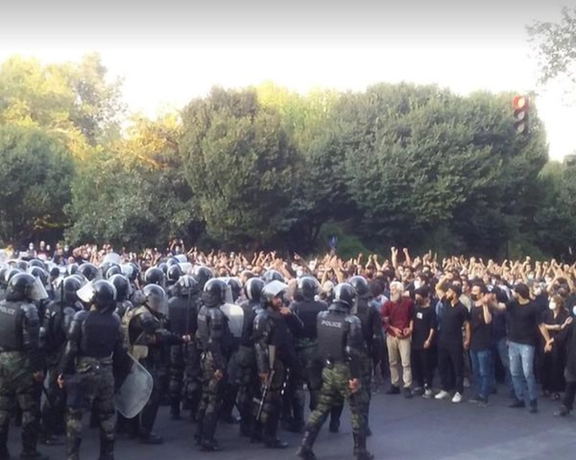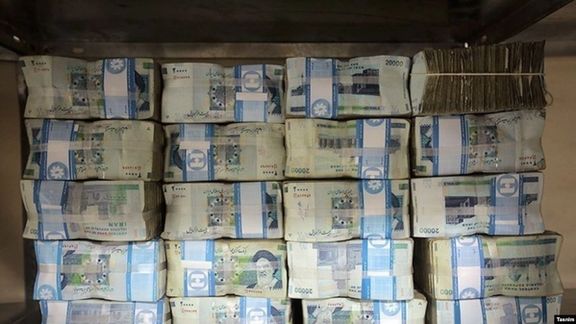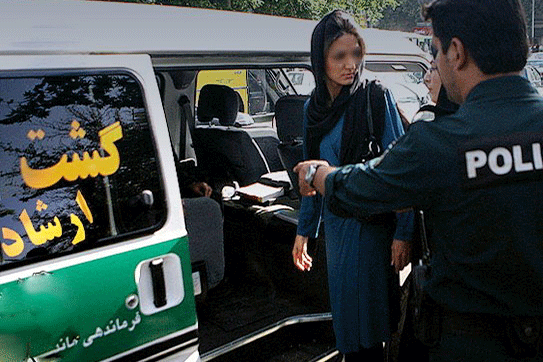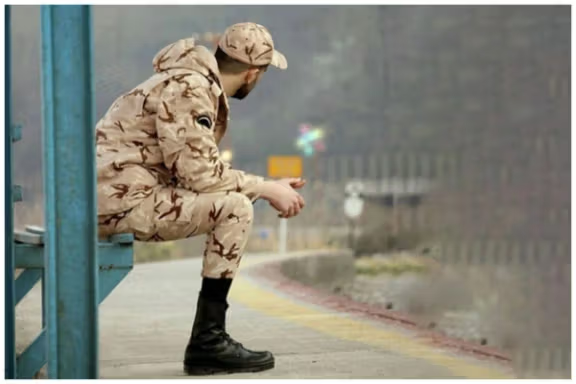Related Articles

In his Eid al-Fitr sermon, Ali Khamenei once again voiced concern about the possible resurgence of anti-government protests in Iran, using his signature rhetoric to warn of a "new sedition."
But the fundamental question remains: who is the real seditionist? Is it the Iranian people protesting the country’s dire conditions—or is it Khamenei himself, who has held power for over three decades? Who is responsible for the current state of affairs that has him so worried? Who has ruled the country and made all major decisions over the past 36 years—ordinary citizens or Khamenei himself?
Khamenei labeling public protests as "sedition" and dismissing demonstrators as seditious is nothing new. This has always been his approach. He has never been willing to acknowledge that Iranian citizens are reacting to the country's deteriorating conditions, which are a direct result of his policies as supreme leader. He has consistently refused to recognize these protests as legitimate, branding them as riots in order to justify their suppression.
He views the citizens who took to the streets in dozens of cities during the 2017, 2019, and 2022 uprisings as being influenced by foreign enemies. But is this really plausible? Khamenei refuses to accept that these protests are domestic and popular in nature. He uses the label of unrest to delegitimize them.
If Khamenei is worried about new protests, he should understand that this fear stems from his own actions. The country’s current state—one that the majority of people reject—is the product of 36 years under his rule, and a decade before that under Khomeini.

For 46 years, no one else has governed Iran. Even the monarchy, which the Islamic Republic continues to criticize and compare itself to, fares better in many metrics. In contrast, the Islamic Republic has dragged the country backward.
After 46 years in power, it is no longer acceptable for the Islamic Republic to measure itself against a government from half a century ago. And even when this comparison is made, in the minds of many Iranians, the Pahlavi era wins, while the Islamic Republic is clearly the loser.
While other nations have advanced in less time, Iran under the Islamic Republic has stagnated or regressed. Dubai and Qatar have achieved modern prosperity in under 46 years. China, now an economic superpower, began its development path after the Islamic Republic came to power—but unlike Iran, it made real progress. The Islamic Republic squandered these decades, pushed the country into ruin, and sacrificed three generations in the process—yet refuses to step aside. Meanwhile, those who object to these conditions are called seditious.
When Khamenei assumed power in 1989, the exchange rate was 1,200 rials to the US dollar. After 36 years of his leadership, it has surpassed one million—a depreciation of 87,000 percent. This isn't mere exaggeration; it’s verifiable with a basic calculation. And still, he labels public protests as sedition and threatens suppression—though such threats have long lost their force.
In just the past four years, the dollar has surged from around 200,000 rials to 1,040,000—more than a fivefold increase. So why wouldn’t people expect the currency to plunge further, possibly hitting one billion rials, if the current trajectory and war-driven policies continue?

Given this economic collapse—and the fact that widespread poverty and dissatisfaction are direct consequences of Khamenei’s rule—how can he possibly justify calling protesters seditious?
Even some of Khamenei’s own allies, like former deputy parliament speaker Mohammadreza Bahonar, have admitted that inflation has hovered at 40 percent for the past seven years. Inflation, in essence, is a legalized form of theft by the state—citizens go to sleep at night and wake up to find their savings eroded.
Even former president Hassan Rouhani, a figure deeply entrenched in Iran’s security apparatus, has openly stated that the people are unhappy.
When individuals who played key roles in cracking down on the 2017 and 2019 protests now speak of widespread dissatisfaction, how can Khamenei still claim these movements are foreign-led?
Many Islamic Republic officials have warned that the public will once again take to the streets—an outcome of the government’s own policies. If anything needs to change, it is the behavior of those in power, not the people.
Numerous insiders have acknowledged the failures of the Islamic Republic’s domestic and foreign policies, especially regarding the US and Israel. Khamenei and the Revolutionary Guard’s staunch anti-American and anti-Israeli stance has not only devastated the economy but also edged the country closer to a potentially catastrophic war.
Sanctions, largely driven by Tehran’s belligerent foreign policy, have primarily harmed ordinary Iranians—while enriching commanders of the Revolutionary Guard.
Mohammad Hossein Adeli, a former Central Bank governor, revealed that in just one year, efforts to circumvent sanctions—managed by the Revolutionary Guard—cost the country $50 billion.
Where did that money go? Beyond international middlemen, much of it ended up in the hands of IRGC commanders and oil smuggling networks. They call it “bypassing sanctions,” but in practice, it’s looting the nation while claiming sacrifice and heroism.
Naturally, the Guard will seek to protect this $50 billion racket—so it continues echoing anti-American policies. After all, it’s the people who pay the price, not the IRGC.
The reality is that through flawed domestic and foreign policies, the Islamic Republic has pushed Iran into a full-blown crisis. Public frustration and anger towards the ruling system is undeniable. The responsibility for this crisis rests squarely on Ali Khamenei and the government he leads.
Ultimately, public protests driven by economic collapse, corruption, and authoritarianism cannot be ignored—and they will inevitably erupt again. But the core question remains: in a country where even officials acknowledge the people's dissatisfaction, who is the real source of sedition—the people, or Ali Khamenei?

On March 8, 1979, tens of thousands of Iranian women took to the streets, demanding the right to choose what to wear on the first International Women’s Day of the post-revolutionary Iran.
The rally that was supposed to be a celebration of women, became the start of a six-day battle against the newly imposed Islamic dress code on them. It was perhaps the earliest sign that the revolution they had fought for had been hijacked.
Only weeks before, many of these same women—students, doctors, lawyers, nurses, teachers, activists—had marched against the dictatorial rule of Mohammad Reza Shah Pahlavi, fighting for freedom, democracy, and equality, unaware that they would become the first victims of Iran’s Islamization led by Ayatollah Ruhollah Khomeini.
On March 7, 1979, Khomeini decreed that all women working in government offices must heed Islamic diktats and cover their hair. The following day, women arriving at work unveiled were turned away.
Many felt this was not about clothes, but control. They saw it as an attempt to erase women from public life. And they fought back.
“We did not rise to go back,” thousands chanted marching from the University of Tehran toward the Prime Minister’s office. “In the dawn of freedom, women’s rights are missing.”
The peaceful demonstration was met with brute force. Islamist revolutionaries and pro-Khomeini mobs stormed the march with sticks and knives. Dissenting women were beaten and stabbed. They were called enemies of Islam and agents of the West.
But they did not back down.
For six days, they marched through the streets of Tehran, defying the cold, the growing danger, and the bitter sneering of those who dismissed their struggle as secondary to the revolutionary cause.
The dismissive view was by no means limited to Iranian masses. It was shared by many Western intellectuals who, bewitched by the revolution in Iran, ignored or actively justified the repression of the new regime.
Thinkers afar: enablers and allies
While feminists like French philosopher Simone de Beauvoir and American writer Kate Millett stood in solidarity with women in Iran, others like de Beauvoir’s compatriot Michel Foucault helped legitimize the Islamic Republic.
De Beauvoir recognized the Iranian women’s fight as part of the global struggle for gender equality, helping establish the International Committee for Women’s Rights (CIDF) to amplify their voices. Millett traveled to Iran to document their struggle and was arrested and expelled for her efforts.
Foucault also visited Iran but had a wholly different view of the events. He romanticized the revolution, reducing it to a rejection of Western imperialism and ignoring its catastrophic consequences for women and dissidents. He brushed aside human rights concerns as Western biases, a framing that persists in various forms to this date.
Another lasting influence in Western intellectual circles is Palestinian-American philosopher and literary critic Edward Said.
Said’s most influential work, Orientalism, was published a year before the revolution in Iran. He focused on Western narratives about the East. While many of his arguments against colonialism were valid, they were weaponized by Islamists to deflect criticism.
Said, unlike Foucault, never glorified Iran’s transformation. Others used his emphasis on culture, however, to depict forced veiling and gender segregation as cultural differences rather than human rights violations, failing to—or choosing not to— challenge the repression in a meaningful way.
A Legacy of Resistance
Back in Iran, the forced veiling of women was completed and codified in 1983. Those daring to flout the law would be punished by official enforcers or emboldened thugs. The Six-Day Protest of 1979 was defeated.
But it heralded a long fight for equality that’s continued to this date.
In 2022, the world watched as Iranians across Iran took to the streets after a 22-year-old Kurdish woman named Mahsa Amini died in custody, having been detained for not covering her hair fully.
Amini’s tragic death—a state murder by all accounts—ignited the largest uprising against the Islamic Republic. Young men tore down posters of supreme leader Ali Khamenei as young women set their scarves on fire.
Their slogan? “Woman, Life, Freedom.”
The struggle against hijab and gender apartheid is not just an Iranian issue—it is a global human rights fight. Iranian and Afghan women continue to resist, even as the Islamic Republic and the Taliban impose laws aimed at erasing them from public life.
What happened on March 8, 1979, is not just history, it is a warning. Revisiting that eventful day and what has happened in Iran since, may help Western intellectuals and politicians see mandatory hijab for what it is: systemic, religious oppression, not a symbol of cultural relativism.
When enforced by law, hijab is not a cultural practice. It is a means of control. Iranian and Afghan women are calling for solidarity, demanding that the world listen to them rather than the Foucaults of the world.
International Women’s Day is a day to honor those who fought and are fighting for equality. It also has to be a day to reject the view that dismisses their struggle, and enables their oppressors.
Opinion expressed by the author are not necessarily the views of Iran International.

The campaigns against advocates of Tehran interests outside Iran is not about stifling debate but ensuring a balanced one, with dissenting voices challenging those more aligned with the Islamic Republic.
The most recent example is the cancelled event at the Berlin-based German Institute for Global and Area Studies (GIGA), scheduled to feature Trita Parsi, co-founder of the Washington-based Quincy Institute for Responsible Statecraft, but much better known as the former head of the National Iranian American Council (NIAC).
Parsi, a longtime supporter of normalizing the US-Iran relations, was set to speak at GIGA earlier this month, but mounting pressure from activists, journalists, and the Iranian diaspora forced the institute to withdraw its platform.
Our position was clear: a figure with a clear history of advocacy for Tehran has to be presented as such, not as an impartial expert; he has to be contested, not granted the whole floor.
Such events as GIGA’s, we argued, undermine serious discussion about Iran and its future. It also raises concerns about why institutions like GIGA and the Körber Foundation continue to give credibility to individuals with well-documented ties to the Islamic Republic.
Parsi took Iranian journalist Hassan Daei to court over such allegations about a decade ago. Consequent US court rulings in 2013 and 2015 dismissed NIAC’s defamation lawsuit, revealing internal emails suggesting the body’s lobbying efforts against sanctions.
A troubling narrative
What we, Iranian dissidents and human rights activists, sought was never silencing someone we disagree with, but to hold accountable institutions that misrepresent as Iran expert figures promoting narratives aligned with Tehran’s interests.
GIGA did eventually cancel the event, citing security concerns. This is deeply problematic as it frames Iranian dissidents—many of whom have suffered the brutality of the Islamic Republic—as aggressors.
No one active in the campaign was a security threat.
The organizers could have opted for a balanced discussion, a forum with different perspectives on Iran. Instead, they planned a one-sided event with a speaker known for advancing Tehran’s talking points, and, when challenged, chose cancellation over honest engagement.
Think Tanks’ role
European think tanks, including GIGA and the Körber Foundation, have repeatedly platformed figures with ties to Tehran, such as Hossein Mousavian, a former Iranian diplomat linked to human rights abuses.
Revelations from Iran International and Semafor last year detailed Tehran’s efforts to embed sympathetic voices in Western institutions to soften its image, oppose sanctions, and push engagement without accountability.
The influence operation, named Iran Expert Initiative (IEI) by those who designed it in Tehran, was reported to have had European support.
A core member of IEI based in Sweden, Roozbeh Parsi—Trita’s brother—said earlier this month that his Iran-related activities were backed by the UK government. This was quickly denied by officials in London.
"We have no record of funding for the IEI or any departmental work with them," the UK Foreign Office said in response to an Iran International inquiry.
So the question raised with the first IEI exposé last year remains: which European government—or governments—funded IEI?
The official inquiry launched by Sweden in response to allegations against Roozbeh Parsi and his employer, Swedish Institute of International Affairs (SIIA), may or may not answer that question. But it’s bound to bring to light more evidence about Tehran’s influence operations.
Would GIGA, SIIA and other such institutions in Europe continue to dismiss these findings or show more openness to criticisms that are ultimately aimed at more informative discussions about Iran?
Road ahead
Those of us involved in the campaign against Trita Parsi’s uncontested platform at GIGA consider its cancellation a positive step—not the balanced debate we sought but better than a free ride for voices that echo Tehran’s and help manipulate narratives in the West.
Institutions like GIGA must recognize that such events come at the cost of those fighting for Iran’s freedom and distort Western policy.
Stricter vetting of speakers is essential. Reputable centers should not leave unchallenged those pushing the agendas of authoritarian regimes. It is quite telling that such figures usually prefer to cancel rather than take part in a multi-voiced forum.
It is also essential that scrutiny is extended beyond individuals to institutions. Other western governments should follow the Swedish lead and investigate whether their public funds have fueled Tehran’s influence operations.
As Washington is set to intensify efforts to confront Iran’s rulers, officials in Europe’s capitals should join rather than undermine that campaign.

Iran has expanded its cyber warfare capabilities in recent years, exposing vulnerabilities in US defenses, meddling in election campaigns even, while policymakers in Washington debate the proper response.
As a cyber espionage investigator focused on Iranian state-sponsored hacking, I’ve observed these operations evolve steadily—from initial reconnaissance to targeted intrusions.
Even when US agencies unmask these hackers, legal and enforcement actions often drag on for months or years, allowing adversaries to rebrand and operate under new aliases.
Yaser Balaghi Inalou, one of three Iranian hackers recently indicted by the Department of Justice for a hack and leak operation targeting the 2024 presidential election, was exposed as early as 2015 by the Israeli security firm Check Point.
Had US agencies exposed him at the time, it might have fractured his network and even disrupted the attack on Donald Trump’s 2024 campaign.
With President Trump’s second term underway and the possibility of deepened tensions between Tehran and Washington, a cohesive and decisive strategy to address this threat seems imperative.
Intelligence agencies may unmask hackers quickly. But those unmasked would regroup and evolve if legal and enforcement responses are delayed. Greater collaboration may be required between federal agencies like the FBI and the Department of Homeland Security, even with private cybersecurity firms, to ensure swift countermeasures such as targeted sanctions and asset freezes.
Also important would be rebuilding trust in US whistleblower programs. Insider intelligence from those with firsthand knowledge of Iranian cyber operations—whether from inside Iran or abroad—can be invaluable.
The current track record of the Rewards for Justice (RFJ) program discourages potential informants. Its FAQ page still highlights cases from 1995 and 2007, with no reference to payouts for whistleblowers in Iranian cyber operations.
Providing a recent example on its website or social media could restore credibility and encourage more people to come forward. As it stands, many of those engaging with the program on social media view it as more of a stunt than a serious incentive.
Public exposure of Iranian cyber operatives is another critical measure. Many operatives hide behind the guise of IT professionals. Publishing updated lists of identified operatives in English and Persian could help rid these groups of the secrecy on which they rely.
Sanctions and asset seizures also remain powerful tools. Iran’s cyber operations are largely directed by state entities like the Ministry of Intelligence and the Islamic Revolutionary Guard Corps (IRGC), already designated as a terrorist organization by the US. Expanding efforts to track and freeze financial assets tied to these entities could significantly disrupt Tehran’s ability to fund its hacker networks.
The importance of swift and proportional countermeasures cannot be overstated. Delayed responses—sometimes by as much as a year—reduce deterrence and embolden threat actors.
Strengthening alliances and building a collective defense mechanism would also enhance deterrence by creating a more formidable response.
The United States relies on digital systems, from essential public services to financial networks. As the reliance grows, so does the threat posed by Iranian cyber operations, likely expanding as Tehran tries to avoid traditional military confrontation.
With the changing of the guards in Washington, new policies should be devised to protect the US digital infrastructure while holding Iran accountable for its online aggression. The implications of inaction are clear—continued vulnerability and escalating threats.

Iranian-Canadian activists fought for a decade to have Canada designate the Islamic Revolutionary Guard Corps (IRGC) as a terrorist organization, not to punish its hapless conscripts.
The long calls for listing the IRGC became too loud to ignore in 2022. Thousands of Iranians marched in Canada for weeks, denouncing the guards' brutality back home, they killed and maim to quell the uprising known by its central chant, Woman Life Freedom.
In April 2023, I helped organize Montreal’s first rally demanding the listing by the Canadian and UK governments. A year later, our efforts bore fruit with Parliament’s unanimous vote supporting the IRGC’s designation as a terrorist entity.
But the triumph that followed after the official listing yielded no solace. Within months, former conscripts were targeted. Branded as IRGC members, they saw their application for permanent residency (PR) denied. Procedural fairness letters piled up.
We had long warned about this and were assured by Canada’s government that the listing would be conducted with precision, ensuring that conscripts would not suffer.
Canada’s prime minister Justin Trudeau confirmed this publicly in a PS752 commemoration day. “We know there is more to do to hold the regime to account and we will continue our work, including continuing to look for ways to responsibly list the IRGC as a terrorist organization.”
The key word was “responsibly”. He signaled that his government understood that the designation could come with complications, particularly for conscripts, and was ready to tackle it.
That’s not how it’s turned out though. The debacle we see today is not what we fought for.
Forsaken at the edge
The listing has left countless individuals in ruins. Their accounts reveal a systemic thoughtlessness that is perpetuating this injustice.
Take Sina, a father of two, denied residency after five years of work in Canada. He was accused of being an IRGC-affiliated university lecturer during his military service. His documents, though, showed he served as a faculty member at Islamic Azad University, fulfilling mandatory service by law.
The irony is that all cards issued to conscripts completing their service in this scheme are categorized under the IRGC branch of Iran’s Military Service Organization. The IRGC’s security-oriented universities like Imam Hussain University, where real associations occur, have faculty who are career IRGC members or state affiliates, their identities largely concealed. The Canadian system, nonetheless, reduces everything to a conscription card, ignoring the realities of compulsory service.
The anatomy of compulsion
Each year, hundreds of thousands are conscripted into a mechanistic system, serving no more than two years. Assignments are normally not known in advance. A prospective conscript may be called to serve in the Army, Police, or IRGC. He would have to endure a few months of rough training followed by many more months of mundane work.

IRGC conscription—not to be mistaken with actual recruitment which leads to membership—is generally less rigorous than other military organizations, exposing the hollow grandeur ascribed to its service.
Mandatory conscription imposes duties on all conscripts, regardless of their past or branch. These typically involve administrative tasks, logistical support, or basic labor, with educated conscripts teaching or assisting in research but excluded from sensitive roles.
The banality of compulsory service is evident in the preferential treatment of those affiliated with the paramilitary Basij, who enjoy months of service reductions. Others, ordinary young men who are assigned to IRGC, are in some ways making up for the Basijis who remain fully active but in their own bases outside the conscription ecosystem.
The IRGC could never function if it relied on annual conscription or allowed the unwilling draftees to access to its modus operandi.
The importance of this fact cannot be overstated: no conscript in Iran qualifies as a member of a military organization in Iran, least of all the IRGC. Many IRGC conscripts are trained in civilian trades such as woodwork or plumbing, just as they do in the Army.
Conscription is a dated, largely unnecessary system, going back to 1925, when Iran wanted to fashion its first modern armed force. Conscripts do not join the IRGC, they are called to do their term. Conflating conscription with membership is wrong—and in Canada, at least, is destroying lives.
IRGC members arise through specialized domains, not brief, menial service often deemed the worst of youths’ lives.
The IRGC operates its own well-established, high-security universities and recruitment centers, with specialized training that prepares loyal individuals for service, be it in the Quds force, Cyber or Aerospace divisions.. To equate these members, the Sepahis, with conscripts who toil for two years to get an end-of-service card that’s required for any job, any transaction, to register marriage even, is a farce bordering on moral bankruptcy.
The Canadian government, long briefed on these matters, bears the responsibility to educate its immigration officers properly.
Guilty until proven innocent
Take another example: Alireza, whose PR application was denied because his two-year conscription with the IRGC was deemed membership. An immigration officer redefined his service as formal affiliation, claiming “membership does not have a temporal element.”
This argument, appearing in many cases, disregards the IRGC’s distinct recruitment process and its separation from mandatory military service. Even the federal court precedents referenced in refusal letters, such as Afanasyev v. Canada, 2012, are tenuous to conscription cases.

In Jalloh v. Canada, 2012, the court stated, “A person cannot be considered a member of a group when his or her involvement with it is based on duress.” That should apply to Alireza and others who had no choice but to do their time with the armed forces. Iran’s compulsory military service is by definition serving under duress.
Masoud, too, faced a refusal rooted in flawed interpretations. Despite detailing his basic training and mundane tasks like checking sign-in sheets, he received a letter that lectured him on the IRGC’s history, followed by a barrage of absurd questions: “If you are no longer involved with the IRGC, when and why did you leave?” or “Did you ever try to escape your duties?”
These betray a limited grasp of military service in Iran and severe punishments deserters face, including the loss of civil rights, acknowledged even in Canadian tribunal records.
Ironically, all those Iranians affected by the IRGC’s designation have declared their service voluntarily, while real IRGC operatives and affiliates—masters of covert operations and false identities—remain untouched. To date, no IRGC career member has been identified or penalized under current nebulous policies.
In refusal letters shared with me the individuals are accused of terrorism by a representative of the Minister of Immigration pursuant to IRPA. Shockingly, the same ministry denies targeting conscripts when speaking to Farsi-speaking outlets, cloaking itself in propaganda despite overwhelming evidence. This travesty, if deliberate, betrays any commitment to fairness and rectitude.
Trudeau’s government cannot feign ignorance of Iran’s conscription ecosystem. For years, advocates and victims laid the truth bare, only to see it dismissed. It is time to bring aspects of this truth to the forefront, demanding a fair reckoning.
The Fight for Redemption
Kaveh Shahrooz, a Canadian lawyer and advocate for listing the IRGC, likens conscripts to hostages of the regime. Freed at last, many are now finding their lives taken hostage again by their innocent past, by an immigration system that purports to be fighting their hostage-takers in Iran.
Some among the Iranian community in Canada—accused of sympathizing with the Islamic Republic—have sought to take advantage of the conscripts’ plight, demanding the removal of its terrorist designation. Former conscripts and families have condemned this move, stressing that they are “innocent individuals forcibly conscripted and enslaved by the IRGC.”
Feeling abandoned by Canada’s Liberal administration, they hope for reprieve through other legislative avenues. Bill C-350, introduced by Conservatives, serves as an example and proposes an exception for conscripts. Thousands have rallied behind it, motivated by Pierre Poilievre’s assurance of protection for those conscripted.
Resolving this issue is crucial for Canada’s standing and could set a precedent for nations like the UK and Australia. Failing to address conscripts’ suffering risks eroding diaspora support, already scarred by the IRGC’s brutality. Should this tragic course continue, there will be only one victor: the IRGC.
True accountability demands Canada hear the voices of innocent conscripts today and confront its failure with integrity and principle.
